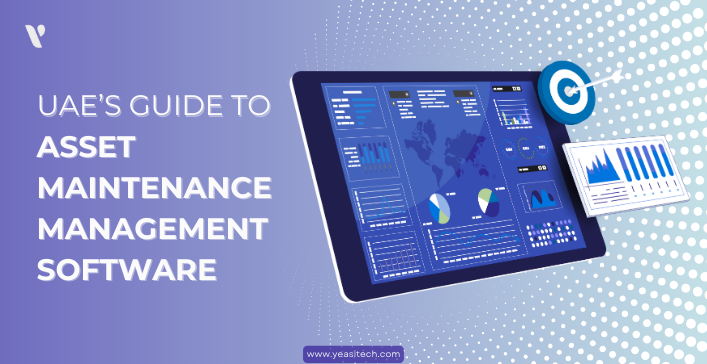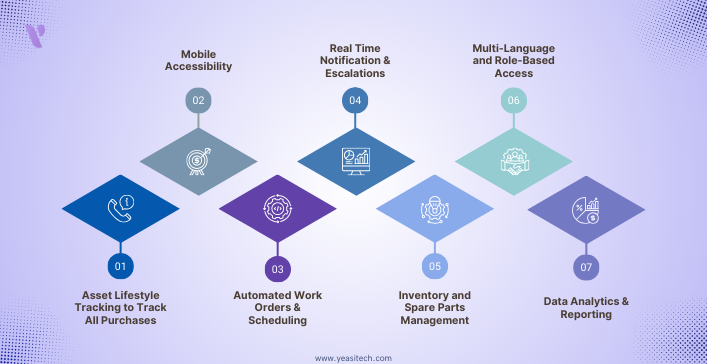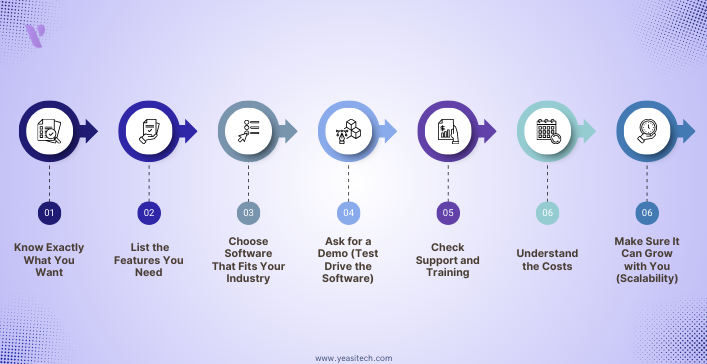Top Features to Look for in Asset Maintenance Management Software in the Middle East in 2025

In the high-stakes world of business operations, one silent hero keeps everything humming along—asset maintenance management software. Imagine a gigantic desalination plant in Abu Dhabi, a solar farm in Sharjah, or a busy airport in Dubai. What if a vital part of their infrastructure, like a luggage handling system, turbine, or pump, suddenly failed? The result? Massive delays, risks to public safety, and severe financial losses.
That’s why Asset Maintenance Management Software (AMMS) has become a strategic imperative—not just a nice-to-have tool. In 2025, especially in the Middle East, where infrastructure is expanding rapidly, AMMS helps businesses:
“Maintenance is not just about fixing what’s broken. It’s about preventing the breakage.”
— Ali Khalid, Maintenance Director, Dubai Industrial City
Let’s explore the industries driving the need for asset maintenance management software and the features that truly matter in choosing the right solution.
The UAE is home to some of the world’s most asset-heavy industries, including:
Fun Fact: Dubai aims to have 100% of government buildings digitally maintained by 2030, integrating them into the wider Smart Dubai initiative.
Your asset maintenance management software should be strong and user-friendly, regardless of whether you’re overseeing a fleet of vehicles or keeping an eye on the HVAC systems of a smart building. The following are the primary features to watch for in 2025:

Track every asset from purchase to disposal. This includes:
In 2025, technicians are mobile. Your software should be, too. Field teams should:
No more juggling spreadsheets. Look for:
Instant alerts for issues like temperature spikes, abnormal vibrations, or missed inspections allow your team to respond before damage occurs. Escalation rules ensure unresolved issues are automatically passed to higher levels, preventing critical failures and minimizing downtime.
Track stock levels in real time and automate reordering to ensure parts are always available when needed. This reduces maintenance delays, prevents overstocking, and improves planning across multiple locations.
Crucial for the Middle East’s multilingual workforce. Support for Arabic, English, Hindi, and Tagalog improves communication, while role-based permissions ensure users see only what’s relevant to their responsibilities, enhancing both security and efficiency.
Transform raw data into clear, actionable insights with built-in dashboards and customizable reports. Track key metrics like downtime, costs, MTBF, and identify performance trends to guide better maintenance strategies.
Stat: Companies using automated maintenance systems report a 26% increase in asset uptime and 19% lower maintenance costs (McKinsey, 2024).
PdM, or predictive maintenance, is one of the most innovative aspects of current asset maintenance management software. Predictive maintenance can save unplanned downtime by up to 50% and maintenance expenses by 10–15%, according to PwC Middle East.
It makes use of real-time sensor data (such as temperature, vibration, or wear) to forecast potential asset failures before they happen. The way that companies in the Gulf area handle vital infrastructure is being completely transformed by predictive maintenance, or PdM. You mend things before they fail rather than after they break.
Example: Emirates Airlines has equipped its aircraft maintenance systems with predictive AI that analyzes over 3,000 signals per flight to detect early signs of wear.
This shift is transforming operations from “fix when broken” to “fix before failure.”
“Predictive maintenance aligns perfectly with the UAE’s Vision 2031 goals of efficiency and smart governance.” — Reem Al Hashemi, UAE Minister of State for International Cooperation
In 2025, choosing between cloud-based and on-premises software is more about flexibility and compliance than just cost.
| Feature | Cloud-Based | On-Premises |
| Scalability | High | Medium |
| Cost | Subscription | High upfront |
| Data Access | Anywhere | Local only |
| Security | Advanced encryption; vendor-managed | Fully controlled by client |
| Uptime | 99.9% SLA | Depends on in-house IT |
| Maintenance | Vendor-handled | In-house team needed |
According to IDC MENA 2024, 58% of UAE firms prefer cloud-based AMMS for its agility and remote access benefits.
Fun Fact: Amazon Web Services and Microsoft Azure opened dedicated data centers in the UAE in 2023, solving past data sovereignty concerns.
Your Asset Maintenance Management Software doesn’t work in isolation. It should plug into other tools you’re already using. In 2025, seamless integration is expected. Look for compatibility with:
A real estate firm in Abu Dhabi integrated its Maintenance Management Software with its BMS and ERP. When an HVAC unit malfunctions:
This level of automation improves accountability and reduces response times dramatically.
Think of Asset Maintenance Management Software as a cog in your business engine. When integrated properly, it amplifies efficiency across departments.
Staying compliant in the UAE is serious business. Your Asset Maintenance Management Software should help, not hinder, this goal. In the UAE, following rules and safety standards is not optional—it’s a must. If your business doesn’t follow them, you can get big fines or even be forced to stop operations. Let’s break it down step by step:
There are government organizations in the UAE that set safety and quality rules for different industries. Here are a few big ones:
Each of these groups checks if companies are doing things the right way.
Companies must:
Let’s look at a real story:
“We faced a fine of AED 200,000 for missing HVAC inspection logs. After implementing Asset Maintenance Management Software, compliance went up by 97%.” — Facilities Manager, Sharjah Mall
To stay safe and legal, your maintenance software should help you:
In short, the UAE takes safety and quality very seriously. Good software helps you follow the rules, avoid fines, and protect your business.
Your buildings, equipment, and other assets can be tracked and managed with the use of a variety of software choices. But how do you pick the finest one for your company? Follow these simple steps:

Before you look at any software, ask yourself:
Pro Tip: Write down your goals. This will help you choose the software that actually solves your problems.
Think about what the software should do for you. For example:
Pro Tip: Make a checklist so you can compare different software easily.
Some software is designed specifically for certain types of businesses. For example:
Pro Tip: Pick a system that’s built for your type of work.
Don’t buy without trying! Ask the software company to show you how it works. Even better, let your staff try it too—they’re the ones who will use it every day.
Pro Tip: A “proof of concept” lets you see if it really works for your needs.
Even the best software is useless if no one knows how to use it. Make sure the company:
Pro Tip: Good support makes using the software much easier.
Some software has a monthly fee, while others charge per user. Don’t just look at the price tag. Ask:
Pro Tip: It’s about getting the best return on your investment (ROI), not just the cheapest option.
You might be small now, but what if you double in size next year? You don’t want to switch software again and start over.
Pro Tip: Choose a system that can grow with your business.
“We grew from managing 4 hotels to 22. Choosing scalable Asset Maintenance Management Software saved us from switching systems midway.”— Operations Director, Dubai Hospitality Group
Here’s a simple checklist to guide your decision:
| Question | Why It Matters |
| Is it cloud-based or on-premise? | Choose based on your infrastructure and security needs. |
| Does it support multiple languages? | Vital for UAE’s diverse workforce. |
| Can technicians use it easily? | Adoption depends on user-friendliness. |
| Does it support predictive maintenance? | For long-term cost savings. |
| Is it compliant with UAE regulations? | Avoid legal and operational risks. |
| Does it offer local support? | Faster issue resolution and customization. |
| Is it customizable? | Every industry has unique workflows. |
Tip: Always ask for a live demo and a trial period.

Looking ahead, smart maintenance is getting even smarter.:
Selecting the best asset maintenance management software is essential for future-proofing your company, not just for checking boxes. The perfect solution should empower your team, lower expenses, and boost uptime in addition to managing assets. This includes predictive maintenance, cloud access, compliance, and mobile usability.
Our platform is designed for the UAE’s unique business environment:
Whether you’re a government agency, manufacturer, logistics company, or real estate developer, YeasiTech helps you stay one step ahead of asset failure.
Ready to future-proof your maintenance operations?

Key features include predictive maintenance using AI, IoT-based real-time monitoring, mobile accessibility, cloud deployment, compliance tracking (especially with GCC regulations), multilingual interfaces (Arabic/English), and seamless ERP integration.
Predictive maintenance minimizes equipment downtime in extreme weather and high-utilization environments, helping companies in sectors like oil & gas, manufacturing, and utilities extend asset life and reduce costly disruptions.
Cloud-based solutions are increasingly preferred in the Middle East due to scalability, remote access, and reduced IT overhead. However, on-premise may still be relevant for industries with strict data security or regulatory requirements.
Absolutely. Field technicians across the Middle East benefit greatly from mobile apps that offer work order access, asset scanning, and real-time updates, especially in remote or industrial environments.
It should support ISO standards, local labor laws, environmental safety regulations, and specific industry mandates (e.g., ADNOC compliance in the UAE or SEC standards in Saudi Arabia).
Multilingual interfaces, particularly Arabic and English, ensure wider adoption among diverse workforces, improve data accuracy, and support compliance with regional language policies.
IoT sensors provide real-time data on asset conditions (temperature, vibration, pressure), enabling proactive maintenance and reducing manual inspections, which is ideal for industries like logistics and utilities in the region.
Yes. By automating maintenance schedules, minimizing unexpected breakdowns, and optimizing resource allocation, companies can significantly reduce repair costs, labor inefficiencies, and downtime.
Scalability is crucial. The software should support expanding operations, new asset types, multi-site management, and future tech like AI or blockchain integration without needing a full system overhaul.
YeasiTech is a trusted IT service partner with 8+ years of experience, empowering 250+ businesses with scalable web, mobile and AI solutions.
Explore related topics to broaden your understanding and gain actionable insights that can transform your strategies.